Mace (bludgeon) on:
[Wikipedia]
[Google]
[Amazon]
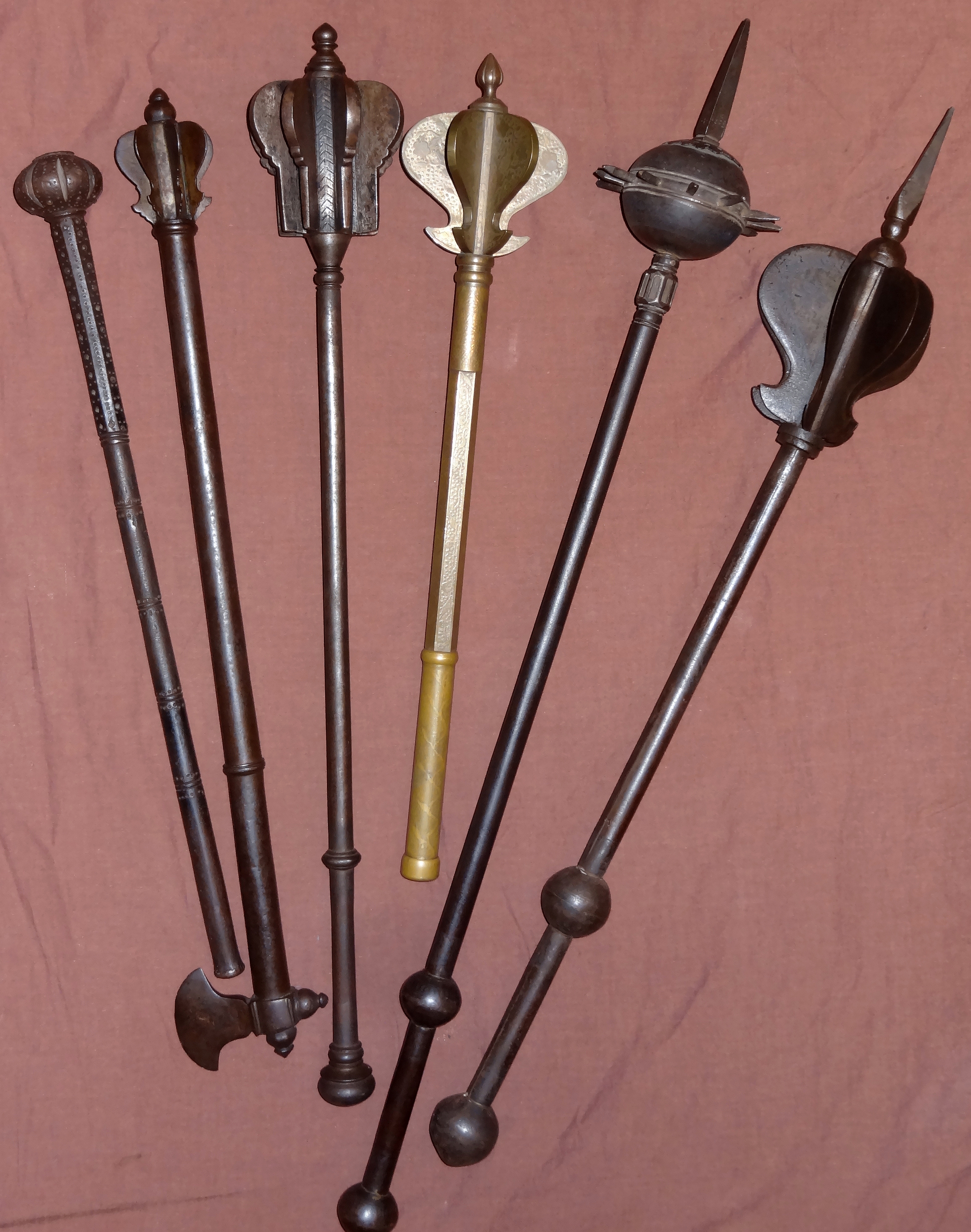 A mace is a blunt
A mace is a blunt
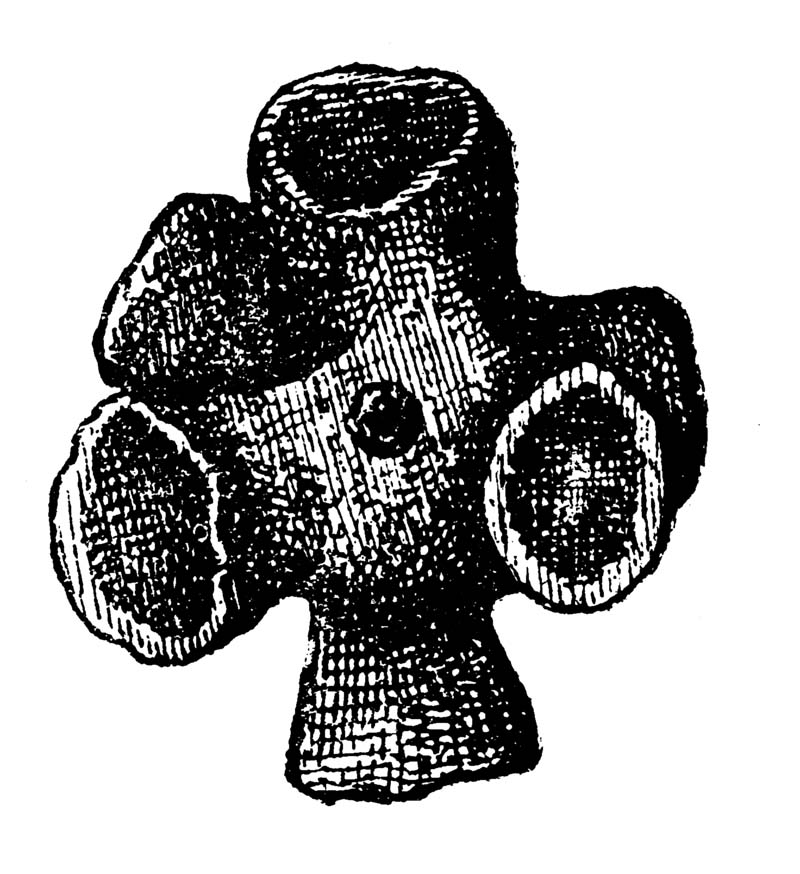 The mace was developed during the
The mace was developed during the 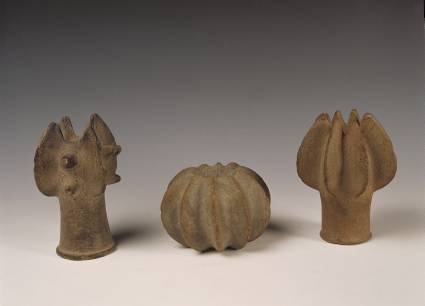 The problem with early maces was that their stone heads shattered easily and it was difficult to fix the head to the wooden handle reliably. The Egyptians attempted to give them a disk shape in the predynastic period (about 3850–3650 BC) in order to increase their impact and even provide some cutting capabilities, but this seems to have been a short-lived improvement.
The problem with early maces was that their stone heads shattered easily and it was difficult to fix the head to the wooden handle reliably. The Egyptians attempted to give them a disk shape in the predynastic period (about 3850–3650 BC) in order to increase their impact and even provide some cutting capabilities, but this seems to have been a short-lived improvement.
 A rounded pear form of mace head known as a "piriform" replaced the disc mace in the Naqada II period of pre-dynastic Upper Egypt (3600–3250 BC) and was used throughout the Naqada III period (3250–3100 BC). Similar mace heads were also used in Mesopotamia around 2450–1900 BC. On a Sumerian Clay tablet written by the scribe Gar.Ama, the title Lord of the Mace is listed in the year 3100 BC. The Assyrians used maces probably about nineteenth century BC and in their campaigns; the maces were usually made of stone or marble and furnished with gold or other metals, but were rarely used in battle unless fighting heavily armoured infantry.
An important, later development in mace heads was the use of metal for their composition. With the advent of copper mace heads, they no longer shattered and a better fit could be made to the wooden club by giving the eye of the mace head the shape of a cone and using a tapered handle.
The Shardanas or warriors from
A rounded pear form of mace head known as a "piriform" replaced the disc mace in the Naqada II period of pre-dynastic Upper Egypt (3600–3250 BC) and was used throughout the Naqada III period (3250–3100 BC). Similar mace heads were also used in Mesopotamia around 2450–1900 BC. On a Sumerian Clay tablet written by the scribe Gar.Ama, the title Lord of the Mace is listed in the year 3100 BC. The Assyrians used maces probably about nineteenth century BC and in their campaigns; the maces were usually made of stone or marble and furnished with gold or other metals, but were rarely used in battle unless fighting heavily armoured infantry.
An important, later development in mace heads was the use of metal for their composition. With the advent of copper mace heads, they no longer shattered and a better fit could be made to the wooden club by giving the eye of the mace head the shape of a cone and using a tapered handle.
The Shardanas or warriors from
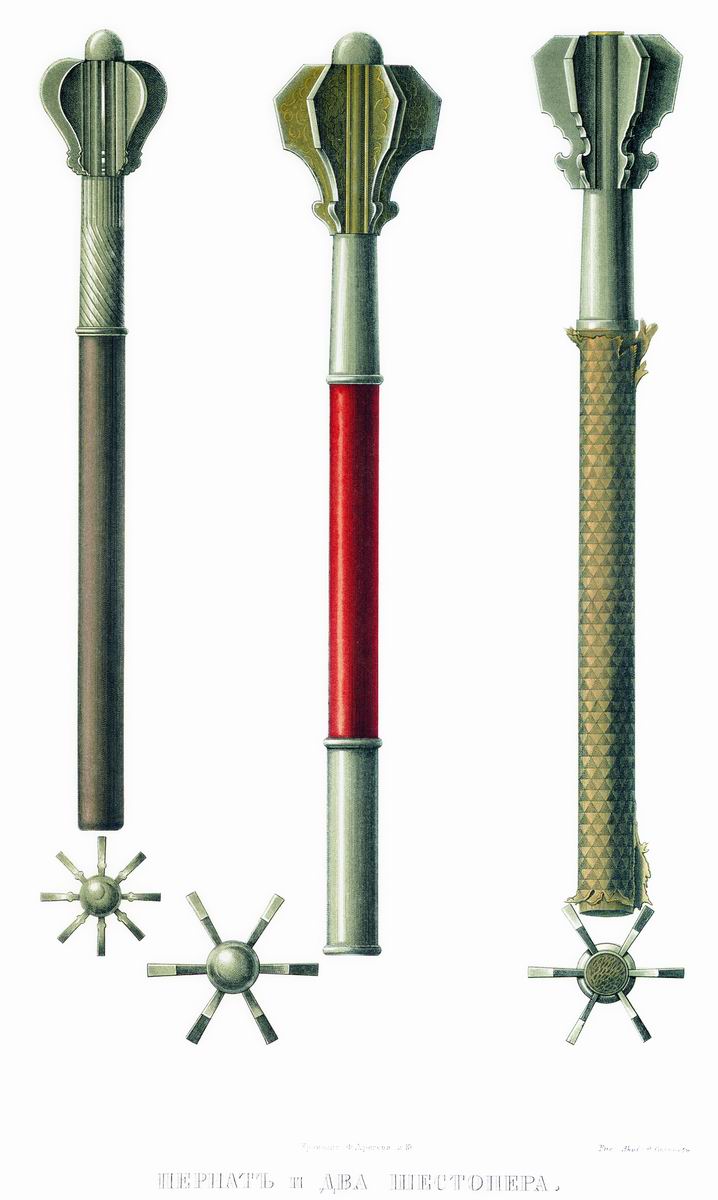 During the
During the
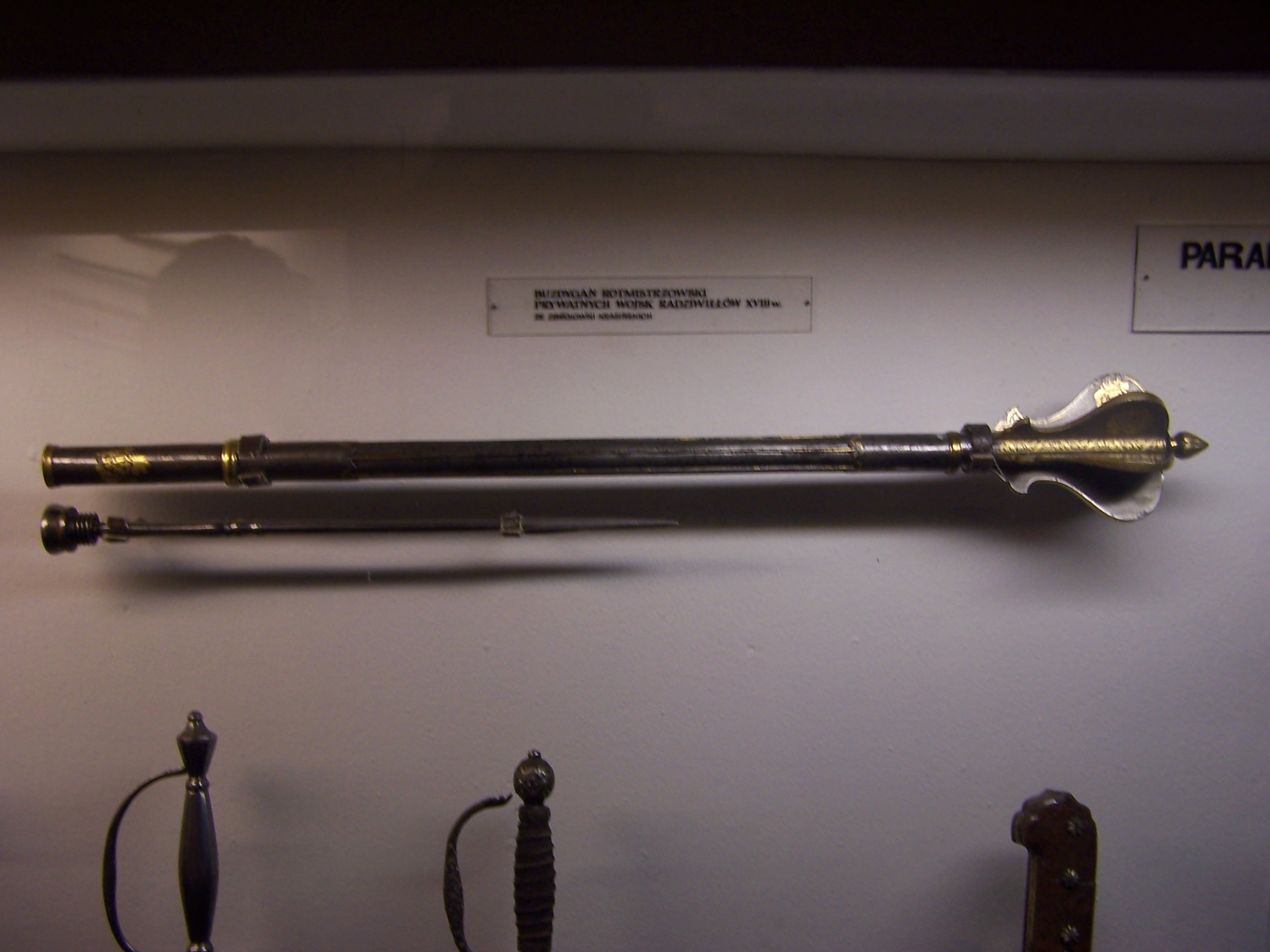 Maces were very common in eastern Europe, especially medieval
Maces were very common in eastern Europe, especially medieval
File:Indian shishpar (flanged mace).jpg, Indian shishpar (flanged mace), all steel construction, with eight knife edged, hinged flanges, 18th-19th century, 26 inches long.
File:Indian shishpar (flanged mace) 3.jpg, Indian shishpar (flanged mace), steel with solid shaft and eight flanged head, 24in.
File:Indian tabar-shishpar 4.jpg, Indian (Deccan) tabar-shishpar, an extremely rare combination tabar axe and shishpar eight flanged mace, steel with hollow shaft, 21.75 in. 17th to 18th century.
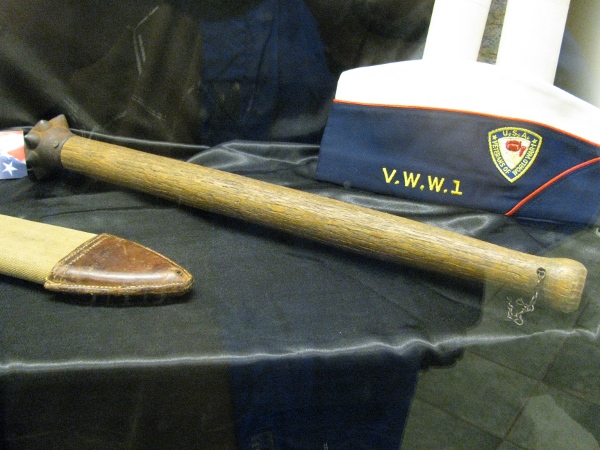 Trench raiding clubs used during
Trench raiding clubs used during
 The ceremonial mace is a short, richly ornamented staff often made of silver, the upper part of which is furnished with a knob or other head-piece and decorated with a coat of arms. The ceremonial mace was commonly borne before eminent ecclesiastical corporations, magistrates, and academic bodies as a mark and symbol of jurisdiction.
Ceremonial maces are important in many
The ceremonial mace is a short, richly ornamented staff often made of silver, the upper part of which is furnished with a knob or other head-piece and decorated with a coat of arms. The ceremonial mace was commonly borne before eminent ecclesiastical corporations, magistrates, and academic bodies as a mark and symbol of jurisdiction.
Ceremonial maces are important in many
 Maces are also used as a parade item, rather than a tool of war, notably in military bands. Specific movements of the mace from the drum major will signal specific orders to the band they lead. The mace can signal anything from a step-off to a halt, from the commencement of playing to the cut off.
Maces are also used as a parade item, rather than a tool of war, notably in military bands. Specific movements of the mace from the drum major will signal specific orders to the band they lead. The mace can signal anything from a step-off to a halt, from the commencement of playing to the cut off.
 University maces are employed in a manner similar to Parliamentary maces. They symbolize the authority and independence of a chartered university and the authority vested in the provost. They are typically carried in at the beginning of a convocation ceremony and are often less than half a meter high.
University maces are employed in a manner similar to Parliamentary maces. They symbolize the authority and independence of a chartered university and the authority vested in the provost. They are typically carried in at the beginning of a convocation ceremony and are often less than half a meter high.
 A mace is a blunt
A mace is a blunt weapon
A weapon, arm or armament is any implement or device that can be used to deter, threaten, inflict physical damage, harm, or kill. Weapons are used to increase the efficacy and efficiency of activities such as hunting, crime, law enforcement, ...
, a type of club or virge that uses a heavy head on the end of a handle to deliver powerful strikes
Strike may refer to:
People
*Strike (surname)
Physical confrontation or removal
*Strike (attack), attack with an inanimate object or a part of the human body intended to cause harm
*Airstrike, military strike by air forces on either a suspected ...
. A mace typically consists of a strong, heavy, wooden or metal shaft, often reinforced with metal, featuring a head made of stone, bone, copper, bronze, iron, or steel.
The head of a military mace can be shaped with flanges or knobs to allow greater penetration of plate armour. The length of maces can vary considerably. The maces of foot soldiers were usually quite short (two or three feet, or sixty to ninety centimetres). The maces of cavalrymen were longer and thus better suited for blows delivered from horseback. Two-handed maces could be even larger.
Maces are rarely used today for actual combat, but many government bodies (for instance, the British House of Commons and the U.S. Congress), universities
A university () is an institution of higher (or tertiary) education and research which awards academic degrees in several academic disciplines. ''University'' is derived from the Latin phrase ''universitas magistrorum et scholarium'', which ...
and other institutions have ceremonial maces and continue to display them as symbols of authority. They are often paraded in academic, parliamentary or civic rituals and processions.
Etymology
The Middle English word "mace" comes from the French "masse" (short for "Masse d'armes") meaning ‘large hammer’, a hammer with a heavy mass at the end.Development history
Prehistory
 The mace was developed during the
The mace was developed during the Upper Paleolithic
The Upper Paleolithic (or Upper Palaeolithic) is the third and last subdivision of the Paleolithic or Old Stone Age. Very broadly, it dates to between 50,000 and 12,000 years ago (the beginning of the Holocene), according to some theories coi ...
from the simple club, by adding sharp spikes of flint
Flint, occasionally flintstone, is a sedimentary cryptocrystalline form of the mineral quartz, categorized as the variety of chert that occurs in chalk or marly limestone. Flint was widely used historically to make stone tools and sta ...
or obsidian.
In Europe, an elaborately carved ceremonial flint mace head was one of the artifacts discovered in excavations of the Neolithic
The Neolithic period, or New Stone Age, is an Old World archaeological period and the final division of the Stone Age. It saw the Neolithic Revolution, a wide-ranging set of developments that appear to have arisen independently in several part ...
mound of Knowth in Ireland, and Bronze Age
The Bronze Age is a historic period, lasting approximately from 3300 BC to 1200 BC, characterized by the use of bronze, the presence of writing in some areas, and other early features of urban civilization. The Bronze Age is the second pri ...
archaeology cites numerous finds of perforated mace heads.
In ancient Ukraine
Ukraine ( uk, Україна, Ukraïna, ) is a country in Eastern Europe. It is the second-largest European country after Russia, which it borders to the east and northeast. Ukraine covers approximately . Prior to the ongoing Russian invas ...
, stone mace heads were first used nearly eight millennia ago. The others known were disc maces with oddly formed stones mounted perpendicularly to their handle. The Narmer Palette shows a king swinging a mace. See the articles on the Narmer Macehead and the Scorpion Macehead for examples of decorated maces inscribed with the names of kings.
 The problem with early maces was that their stone heads shattered easily and it was difficult to fix the head to the wooden handle reliably. The Egyptians attempted to give them a disk shape in the predynastic period (about 3850–3650 BC) in order to increase their impact and even provide some cutting capabilities, but this seems to have been a short-lived improvement.
The problem with early maces was that their stone heads shattered easily and it was difficult to fix the head to the wooden handle reliably. The Egyptians attempted to give them a disk shape in the predynastic period (about 3850–3650 BC) in order to increase their impact and even provide some cutting capabilities, but this seems to have been a short-lived improvement.
 A rounded pear form of mace head known as a "piriform" replaced the disc mace in the Naqada II period of pre-dynastic Upper Egypt (3600–3250 BC) and was used throughout the Naqada III period (3250–3100 BC). Similar mace heads were also used in Mesopotamia around 2450–1900 BC. On a Sumerian Clay tablet written by the scribe Gar.Ama, the title Lord of the Mace is listed in the year 3100 BC. The Assyrians used maces probably about nineteenth century BC and in their campaigns; the maces were usually made of stone or marble and furnished with gold or other metals, but were rarely used in battle unless fighting heavily armoured infantry.
An important, later development in mace heads was the use of metal for their composition. With the advent of copper mace heads, they no longer shattered and a better fit could be made to the wooden club by giving the eye of the mace head the shape of a cone and using a tapered handle.
The Shardanas or warriors from
A rounded pear form of mace head known as a "piriform" replaced the disc mace in the Naqada II period of pre-dynastic Upper Egypt (3600–3250 BC) and was used throughout the Naqada III period (3250–3100 BC). Similar mace heads were also used in Mesopotamia around 2450–1900 BC. On a Sumerian Clay tablet written by the scribe Gar.Ama, the title Lord of the Mace is listed in the year 3100 BC. The Assyrians used maces probably about nineteenth century BC and in their campaigns; the maces were usually made of stone or marble and furnished with gold or other metals, but were rarely used in battle unless fighting heavily armoured infantry.
An important, later development in mace heads was the use of metal for their composition. With the advent of copper mace heads, they no longer shattered and a better fit could be made to the wooden club by giving the eye of the mace head the shape of a cone and using a tapered handle.
The Shardanas or warriors from Sardinia
Sardinia ( ; it, Sardegna, label= Italian, Corsican and Tabarchino ; sc, Sardigna , sdc, Sardhigna; french: Sardaigne; sdn, Saldigna; ca, Sardenya, label= Algherese and Catalan) is the second-largest island in the Mediterranean Sea, af ...
who fought for Ramses II
Ramesses II ( egy, wikt:rꜥ-ms-sw, rꜥ-ms-sw ''Rīʿa-məsī-sū'', , meaning "Ra is the one who bore him"; ), commonly known as Ramesses the Great, was the third pharaoh of the Nineteenth Dynasty of Egypt. Along with Thutmose III he is oft ...
against the Hittites were armed with maces consisting of wooden sticks with bronze heads. Many bronze statuettes of the times show Sardinian warriors carrying swords, bows and original maces.
Ancient history
Persians
The Persians are an Iranian ethnic group who comprise over half of the population of Iran. They share a common cultural system and are native speakers of the Persian language as well as of the languages that are closely related to Persian.
...
used a variety of maces and fielded large numbers of heavily armoured and armed cavalry (see Cataphract
A cataphract was a form of armored heavy cavalryman that originated in Persia and was fielded in ancient warfare throughout Eurasia and Northern Africa.
The English word derives from the Greek ' (plural: '), literally meaning "armored" or "c ...
). For a heavily armed Persian knight
A knight is a person granted an honorary title of knighthood by a head of state (including the Pope) or representative for service to the monarch, the church or the country, especially in a military capacity. Knighthood finds origins in the G ...
, a mace was as effective as a sword or battle axe. In fact, Shahnameh
The ''Shahnameh'' or ''Shahnama'' ( fa, شاهنامه, Šāhnāme, lit=The Book of Kings, ) is a long epic poem written by the Persian poet Ferdowsi between c. 977 and 1010 CE and is the national epic of Greater Iran. Consisting of some 50 ...
has many references to heavily armoured knights facing each other using maces, axes, and swords. The enchanted talking mace Sharur made its first appearance in Sumerian/Akkadian mythology during the epic of Ninurta
, image= Cropped Image of Carving Showing the Mesopotamian God Ninurta.png
, caption= Assyrian stone relief from the temple of Ninurta at Kalhu, showing the god with his thunderbolts pursuing Anzû, who has stolen the Tablet of Destinies from ...
.
The Indian epics ''Ramayana
The ''Rāmāyana'' (; sa, रामायणम्, ) is a Sanskrit epic composed over a period of nearly a millennium, with scholars' estimates for the earliest stage of the text ranging from the 8th to 4th centuries BCE, and later stages e ...
'' and ''Mahabharata
The ''Mahābhārata'' ( ; sa, महाभारतम्, ', ) is one of the two major Sanskrit epics of ancient India in Hinduism, the other being the '' Rāmāyaṇa''. It narrates the struggle between two groups of cousins in the K ...
'' describe the extensive use of the '' gada'' in ancient Indian warfare as gada-yuddha or 'mace combat'.
The ancient Romans did not make wide use of maces, probably because of the influence of armour, and due to the nature of the Roman infantry's fighting style which involved the '' Pilum'' (spear) and the '' Gladius'' (short sword used in a stabbing fashion), though auxiliaries from Syria Palestina were armed with clubs and maces at the battles of Immae and Emesa in 272 AD. They proved highly effective against the heavily armoured horsemen of Palmyra.
Post classical history
Western Europe
 During the
During the Middle Ages
In the history of Europe, the Middle Ages or medieval period lasted approximately from the late 5th to the late 15th centuries, similar to the post-classical period of global history. It began with the fall of the Western Roman Empire ...
metal armour such as mail
The mail or post is a system for physically transporting postcards, letter (message), letters, and parcel (package), parcels. A postal service can be private or public, though many governments place restrictions on private systems. Since the mid ...
protected against the blows of edged weapons. Solid metal maces and war hammers proved able to inflict damage on well armoured knights, as the force of a blow from a mace is great enough to cause damage without penetrating the armour. Though iron became increasingly common, copper and bronze were also used, especially in iron-deficient areas.
One example of a mace capable of penetrating armour is the flanged mace. The flanges allow it to dent or penetrate thick armour
Armour (British English
British English (BrE, en-GB, or BE) is, according to Lexico, Oxford Dictionaries, "English language, English as used in Great Britain, as distinct from that used elsewhere". More narrowly, it can refer specificall ...
. Flange maces did not become popular until after knobbed maces. Although there are some references to flanged maces (''bardoukion'') as early as the Byzantine Empire c. 900 it is commonly accepted that the flanged mace did not become popular in Europe until the 12th century, when it was concurrently developed in Russia and Mid-west Asia.
Maces, being simple to make, cheap, and straightforward in application, were quite common weapons.
It is popularly believed that maces were employed by the clergy in warfare to avoid shedding blood (''sine effusione sanguinis''). The evidence for this is sparse and appears to derive almost entirely from the depiction of Bishop Odo of Bayeux wielding a club-like mace at the Battle of Hastings
The Battle of Hastings nrf, Batâle dé Hastings was fought on 14 October 1066 between the Norman-French army of William, the Duke of Normandy, and an English army under the Anglo-Saxon King Harold Godwinson, beginning the Norman Conquest ...
in the Bayeux Tapestry, the idea being that he did so to avoid either shedding blood or bearing the arms of war.
In the 1893 work ''Arms and Armour in Antiquity and the Middle Ages'', Paul Lacombe and Charles Boutell state that the mace was chiefly used for blows struck upon the head of an enemy.
Eastern Europe
Poland
Poland, officially the Republic of Poland, , is a country in Central Europe. Poland is divided into Voivodeships of Poland, sixteen voivodeships and is the fifth most populous member state of the European Union (EU), with over 38 mill ...
, Ukraine
Ukraine ( uk, Україна, Ukraïna, ) is a country in Eastern Europe. It is the second-largest European country after Russia, which it borders to the east and northeast. Ukraine covers approximately . Prior to the ongoing Russian invas ...
, and Russia
Russia (, , ), or the Russian Federation, is a transcontinental country spanning Eastern Europe and Northern Asia. It is the largest country in the world, with its internationally recognised territory covering , and encompassing one-eigh ...
. Eastern European maces often had pear shaped heads. These maces were also used by the Moldavian ruler Stephen the Great in some of his wars (see Bulawa).
The mace is also the favourite weapon of Prince Marko, a hero in South Slavic epic poetry.
The pernach was a type of flanged mace developed since the 12th century in the region of Kievan Rus'
Kievan Rusʹ, also known as Kyivan Rusʹ ( orv, , Rusĭ, or , , ; Old Norse: ''Garðaríki''), was a state in Eastern and Northern Europe from the late 9th to the mid-13th century.John Channon & Robert Hudson, ''Penguin Historical Atlas of ...
, and later widely used throughout the whole of Europe
Europe is a large peninsula conventionally considered a continent in its own right because of its great physical size and the weight of its history and traditions. Europe is also considered a subcontinent of Eurasia and it is located enti ...
. The name comes from the Slavic word ''pero'' (''перо'') meaning feather, reflecting the form of pernach that resembled a fletched arrow
An arrow is a fin-stabilized projectile launched by a bow. A typical arrow usually consists of a long, stiff, straight shaft with a weighty (and usually sharp and pointed) arrowhead attached to the front end, multiple fin-like stabilizers ...
. Pernachs were the first form of the flanged mace to enjoy a wide usage. It was well suited to penetrate plate armour and chain mail
Chain mail (properly called mail or maille but usually called chain mail or chainmail) is a type of armour consisting of small metal rings linked together in a pattern to form a mesh. It was in common military use between the 3rd century BC and ...
. In the later times it was often used as a symbol of power by the military leaders in Eastern Europe
Eastern Europe is a subregion of the European continent. As a largely ambiguous term, it has a wide range of geopolitical, geographical, ethnic, cultural, and socio-economic connotations. The vast majority of the region is covered by Russia, wh ...
.
Pre-Columbian America
The cultures of pre-Columbian America used clubs and maces extensively. The warriors of the Moche state and theInca Empire
The Inca Empire (also known as the Incan Empire and the Inka Empire), called ''Tawantinsuyu'' by its subjects, ( Quechua for the "Realm of the Four Parts", "four parts together" ) was the largest empire in pre-Columbian America. The adm ...
used maces with bone, stone or copper heads and wooden shafts.
Asia
Maces in Asia were most often steel clubs with a spherical head. In Persia, the "Gorz" (spherical-head mace) served as a primary combat arm across many eras, most often being used by heavy infantry or Cataphracts. In India a form of these clubs was used by wrestlers to exercise the arms and shoulders. They have been known as gada since ancient times. During the Mughal era, the flanged mace of Persia was introduced to South Asia. The term ''shishpar'' is a Persian phrase which literally translates to "six-wings", to refer to the (often) six flanges on the mace. The shishpar mace was introduced by the Delhi Sultanate and continued to be utilized until the 18th century.Modern history
World War I
World War I (28 July 1914 11 November 1918), often abbreviated as WWI, was List of wars and anthropogenic disasters by death toll, one of the deadliest global conflicts in history. Belligerents included much of Europe, the Russian Empire, ...
were modern variations on the medieval mace. They were homemade mêlée weapons used by both the Allies and the Central Powers
The Central Powers, also known as the Central Empires,german: Mittelmächte; hu, Központi hatalmak; tr, İttifak Devletleri / ; bg, Централни сили, translit=Tsentralni sili was one of the two main coalitions that fought in ...
. Clubs were used during night time trench raiding expeditions as a quiet and effective way of killing or wounding enemy soldiers.
Makeshift maces were also found in the possession of some football hooligans in the 1980s.
In 2020 China–India skirmishes personnel of People's Liberation Army Ground Force
The People's Liberation Army Ground Force (PLAGF; ) is the land-based service branch of the People's Liberation Army and the largest and oldest branch of the entire Chinese armed forces. The PLAGF can trace its lineage from 1927 as the Chines ...
were seen using makeshift maces (batons wrapped in barbed wire and clubs embedded with nails).
Ceremonial use
Maces have had a role in ceremonial practices over time, including some still in use today.Parliamentary maces
 The ceremonial mace is a short, richly ornamented staff often made of silver, the upper part of which is furnished with a knob or other head-piece and decorated with a coat of arms. The ceremonial mace was commonly borne before eminent ecclesiastical corporations, magistrates, and academic bodies as a mark and symbol of jurisdiction.
Ceremonial maces are important in many
The ceremonial mace is a short, richly ornamented staff often made of silver, the upper part of which is furnished with a knob or other head-piece and decorated with a coat of arms. The ceremonial mace was commonly borne before eminent ecclesiastical corporations, magistrates, and academic bodies as a mark and symbol of jurisdiction.
Ceremonial maces are important in many parliament
In modern politics, and history, a parliament is a legislative body of government. Generally, a modern parliament has three functions: representing the electorate, making laws, and overseeing the government via hearings and inquiries. ...
s following the Westminster system. They are carried in by the sergeant-at-arms or some other mace-bearers and displayed on the clerks' table while parliament is in session to show that a parliament is fully constituted. They are removed when the session ends. The mace is also removed from the table when a new speaker is being elected to show that parliament is not ready to conduct business.
Ecclesiastical maces
Maces may also be carried before clergy members in church processions, although in the case of the Roman Catholic pope and cardinals, they have largely been replaced withprocessional crosses
A processional cross is a crucifix or cross which is carried in Christian processions. Such crosses have a long history: the Gregorian mission of Saint Augustine of Canterbury to England carried one before them "like a standard", according to ...
.
Parade maces
University maces
Heraldic use
Like many weapons from feudal times, maces have been used in heraldic blazons as either a charge on a shield or other item, or as external ornamentation. Thus, in France: * the city of Cognac (in the Charente département): ''Argent on a horse sable harnessed or a man proper vested azure with a cloak gules holding a mace, on a chief France modern'' * the city ofColmar
Colmar (, ; Alsatian: ' ; German during 1871–1918 and 1940–1945: ') is a city and commune in the Haut-Rhin department and Grand Est region of north-eastern France. The third-largest commune in Alsace (after Strasbourg and Mulhouse), ...
(in Haut-Rhin
Haut-Rhin (, ; Alsatian: ''Owerelsàss'' or '; german: Oberelsass, ) is a department in the Grand Est region of France, bordering both Germany and Switzerland. It is named after the river Rhine. Its name means ''Upper Rhine''. Haut-Rhin is th ...
): ''per pale gules and vert a mace per bend sinister or.'' Three maces, probably a canting device (''Kolben'' means mace in German, cfr. ''Columbaria'' the Latin name of the city) appear on a 1214 seal. The arms in a 15th-century stained-glass window show the mace per bend on argent.
* the duke of Retz (a pairie created in 1581 for Albert de Gondy) had ''Or two maces or clubs per saltire sable, bound gules''
* the Garde des sceaux ('keeper of the seals', still the formal title of the French Republic's Minister of Justice) places behind the shield, two silver and gilded maces in saltire, and the achievement is surmounted by a mortier (magistrate's hat)
See also
*Barsom
A barsom is a ritual implement used by Zoroastrian priests to solemnize certain sacred ceremonies.
The word ''barsom'' derives from the Avestan language ''baresman'' (trisyllabic, '), which is in turn a substantive of ''barez'' "to grow high. ...
* Bulawa
* Ceremonial maces in the British Isles
* Gada (weapon)
* Flail (weapon)
* Kanabō
* Horseman's pick
The horseman's pick was a weapon of Middle Eastern origin used by cavalry during the Middle Ages in Europe and the Middle East. This was a type of war hammer that had a very long spike on the reverse of the hammer head. Usually, this spike was ...
* Mace of the United States House of Representatives
* Morning star (weapon)
* Shillelagh (club)
* War hammer
Notes
References
* ''Dictionary of Medieval Knighthood and Chivalry'' by Bradford Broughton (NY,Greenwood Press
Greenwood Publishing Group, Inc. (GPG), also known as ABC-Clio/Greenwood (stylized ABC-CLIO/Greenwood), is an educational and academic publisher (middle school through university level) which is today part of ABC-Clio. Established in 1967 as G ...
, 1986, )
* ''Hafted Weapons in Medieval and Renaissance Europe: The Evolution of European Staff Weapons Between 1200 and 1650'' by John Waldman ( Brill, 2005, )
* ''Medieval Military Technology'' by Kelly DeVries (Broadview Press, 1998, 0-921149-74-3)
External links
* {{DEFAULTSORT:Mace (Club) Clubs (weapon)